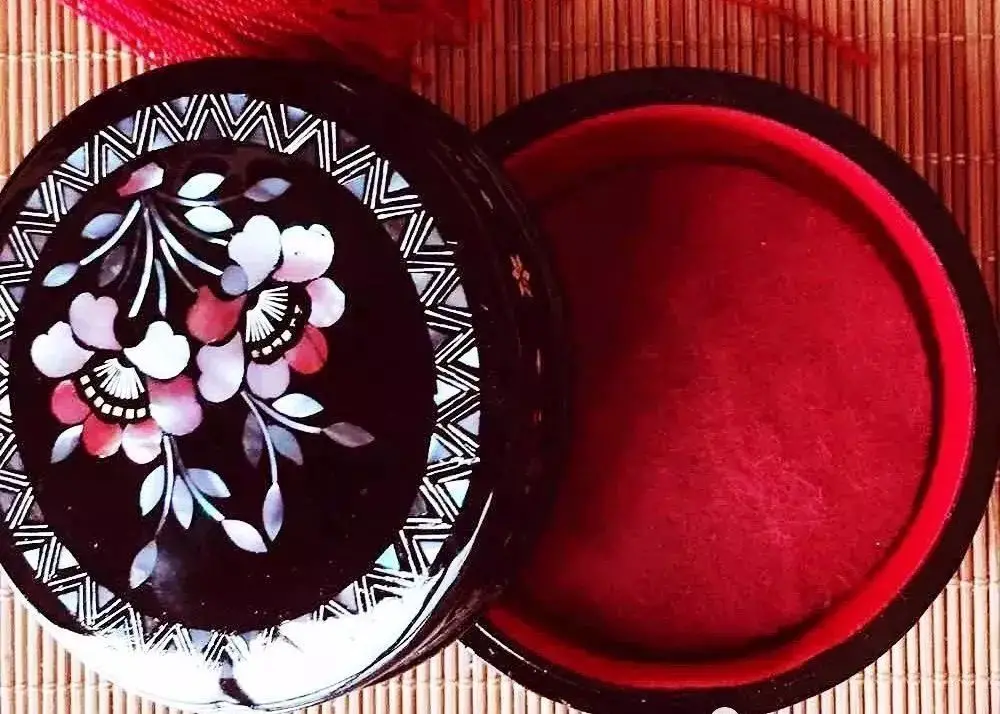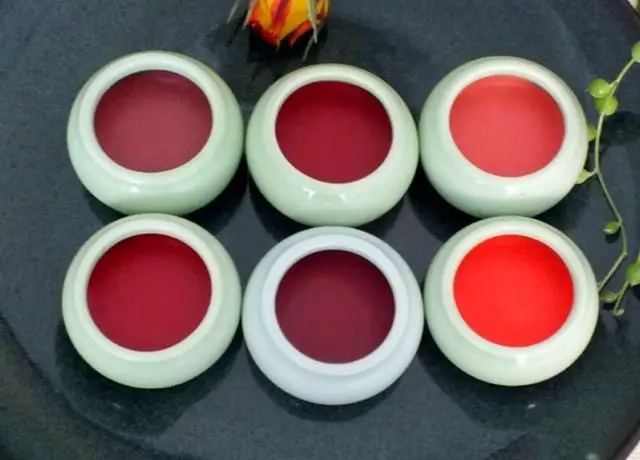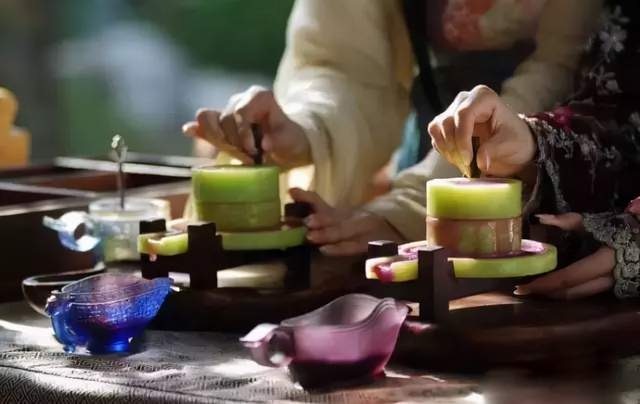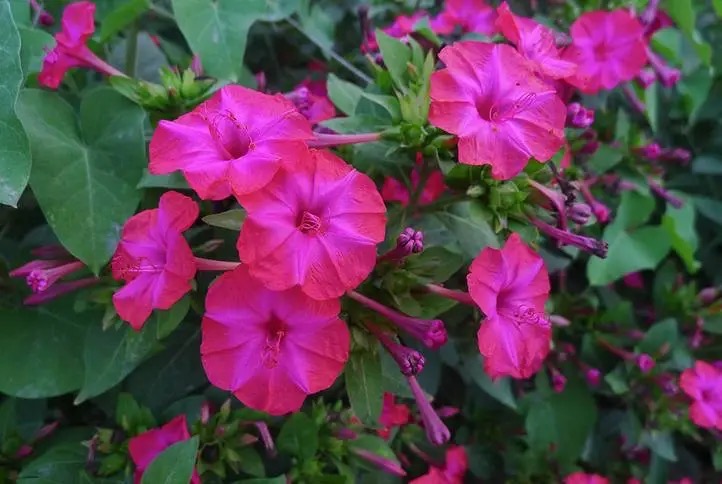Chinese Rouge, also known as “blush” or “rouge powder,” is a traditional makeup product used in China. Its history can be traced back to ancient times, where it was widely used by women of all ages and social classes.
what is ancient Chinese rouge?
Yanzhi, also known as Rouge, refers to a cosmetic product applied to the cheeks to create a three-dimensional effect and present a healthy and rosy complexion. Typically, it uses red pigments, but there are also brown, blue, bronze, and beige tones to suit contouring needs. Rouge, also called blush, is a cosmetic product belonging to beauty and makeup. When applied to the cheeks, especially the apples, it brightens the complexion, adds a rosy glow, and creates a three-dimensional effect by shading, enhancing beauty and a healthy appearance. Rouge comes in various forms, such as solid, cream, and liquid, similar to foundation.
The use of Chinese Rouge is rooted in the Chinese belief that a woman’s complexion reflects her overall health and beauty. In ancient times, it was believed that applying makeup, including Chinese Rouge, not only enhanced a woman’s physical appearance but also promoted good health and a long life.

Chinese rouge style
Rouge is a cosmetic product used to enhance and beautify the cheeks. It is a key member of the family of facial cosmetics, alongside creams and powders. In terms of ingredients and formulation, it is very similar to powder cosmetics and can be classified as such. When it comes to importance, it can be seen as equal to foundation. “Putting on rouge and powder” makes sense, with rouge being placed at the forefront. Rouge is a red pigment-containing product with iron. It comes in cream, paste, powder, and compact powder formulations, with varying shades of color. When applied to the cheeks, it can create a sense of depth and a healthy complexion. The main ingredients of rouge are basically the same as those of powder, including talc, kaolin, zinc oxide, as well as fragrance and pigments. Some high-end rouge products also contain lanolin, white vaseline, and floral fragrances.
In ancient times, there were several types of rouge:
(1) Cream rouge: This type of rouge contains a certain amount of oil. It is generally in a paste form and is suitable for dry skin. It feels soft and has bright colors. When used, it is applied evenly with the fingertips on the cheeks.
(2) Powder rouge: This type of rouge is made by compressing powder into a block and placing it in a box. The rouge is applied to the face using a rouge brush. Due to its low oil content, it is suitable for oily skin and for use in the summer.
(3) Emulsion rouge: This type of rouge is not widely used in China. It has a good effect on improving the smoothness of the face, is easy to apply, and easy to remove, making it suitable for use on neutral skin.
There are many types of modern rouge, which can be roughly divided into several types such as powder, block, cream, and emulsion.
(1) Rouge block, also known as rouge cake, is a convenient beauty makeup product for modifying the cheeks. Its main components are talc, kaolin, magnesium carbonate, zinc stearate, pigment, lanolin, fragrance, etc.
(2) Rouge cream is a moisturizing and modifying beauty makeup product for the cheeks. According to the different formula and emulsification methods, it can be divided into snowflake-type rouge cream, cold cream-type rouge cream, and transparent rouge cream. Its main components are fatty alcohols, sodium stearate, pigment, fragrance, etc.
(3) Rouge emulsion is a beauty makeup product with a bright color tone and good spreading properties. This type of rouge is especially suitable for those who need to add natural luster to their cheeks, and it is easy to apply and remove. This product is composed of oil and water phases that are emulsified together.
There are nine types of rouge recorded in historical books:
- Cinnabar: also known as mercury sulfide, a naturally occurring mineral.
- Red-blue flower: also known as safflower, dyer’s saffron, or American saffron, it is the crown jewel of rouge-making ingredients.
- Lithospermum erythrorhizon: effective against pigmentation disorders such as freckles, melasma, and scars.
- Lac: also known as sticklac, shellac, or cochineal, used to create a red pigment.
- Caesalpinia sappan: used primarily for dyeing.
- Malva verticillata: used to extract pigments.
- Pomegranate flower: its red color is comparable to that of the red-blue flower.
- Jasminum nudiflorum: also known as the winter jasmine or rouge flower, used for lip coloring.
- Rose: used for extracting pigments and fragrances.

how to say rouge in Chinese?
Rouge was a commonly used cosmetic by women in ancient china, and there are many descriptions of rouge in the classical books of various dynasties, such as “Yanzhi”, “Yanzhi”, “Xianzhi”, “Yanzhi”, “Yanshi”, “Yanshi”, and so on. In the Tang Dynasty, applying lip rouge was also called “dianchun” (dotting lips). During the reign of Emperor Xizong, there were 16 types of lip rouge, including “Pomegranate Beauty”, “Big Red Spring”, “Small Red Spring”, “Tender Wu Xiang”, “Half-side Beauty”, “Golden Red”, “Saint Sandalwood Heart”, “Dew Pearl”, “Internal Family Circle”, “Heavenly Palace Craft”, “Luo Er Yin”, “Light Red Heart”, “Orangutan Blush”, “Small Vermilion Dragon”, “Ge Double Tang”, “Pretty Flower Slave”, collectively referred to as rouge varieties.
rouge in Chinese history
Rouge, also known as “yānzhī” in Chinese, has a long history of use by women in China. It was a popular cosmetic product in ancient times and can be found in many historical records.
In ancient China, women used various types of rouge made from different ingredients, such as cinnabar, safflower, and lead oxide. It was applied to the cheeks and lips to enhance their natural color and create a youthful and attractive appearance.
During the Tang Dynasty (618-907), different varieties of rouge were developed, and there were even different shades of red to suit different skin tones. The emperor at the time, Xizong, had 16 types of rouge named after him, collectively known as the “Yan Zhi Yun Pin” .
Rouge continued to be popular during the Song Dynasty (960-1279), and its production became more sophisticated. The use of natural ingredients, such as red sandalwood and safflower, allowed for the creation of more colors and shades.
In the Ming (1368-1644) and Qing (1644-1912) Dynasties, the production and use of rouge became more widespread. The cosmetic industry developed rapidly, and rouge was used not only by women but also by men.
Today, rouge is still used by some Chinese women, although it has been largely replaced by modern cosmetics. Despite this, the tradition of using rouge remains an important part of Chinese cosmetic culture and history.
who invented Chinese rouge?-rouge origin
There are two theories about the origin of rouge (or yan zhi in Chinese):
One theory is that rouge originated during the Shang and Zhou dynasties. According to Ma Gao’s “Annotations on Ancient and Modern China,” yan zhi (rouge) originated during the time of King Zhou, and was made by solidifying the juice of red and blue flowers and mixing it with grease to adorn women’s faces. It was produced in the region of Yan, which is why it is called yan zhi. This theory is quite plausible, as yan zhi was only called yan zhi when it was produced in the Yan region.
The other theory is that rouge was brought back to China by Zhang Qian, an emissary sent by Han Emperor Wu to the Western Regions, from the Xiongnu. During that time, Xiongnu noblewomen often used “E’shi” (rouge) to beautify themselves, and the practice spread widely. This theory is more likely because the word “yan zhi” evolved from “E’shi” in Xianzhi Mountain of the Xiongnu. Even if there were similar cosmetics during the Shang and Zhou dynasties, they were only similar and did not truly form into what we know as rouge today.

what is Chinese rouge made of?
The main ingredient used to make rouge in ancient times was safflower, also known as Hong Hua or red flower. It was a frequently recorded and commonly used material for medicine, dyeing, and cosmetics in China since the Han Dynasty. Safflower originated in Egypt and was introduced to China through Central Asia during the Han Dynasty. The flower has a beautiful red color, which is why the Huns used it to make pigments and as a cosmetic for women. The word “rouge” is the transliteration and evolution of the Hunnic word for safflower, which was also used to refer to women as “Yan Shi” and mountains with safflowers as “Yan Zhi Shan.”
After the Wei and Jin Dynasties, safflowers were widely cultivated. The “Qi Min Yao Shu” contains a special chapter on safflower cultivation techniques and the manufacturing process of rouge. It is said that the petals of this flower contain two pigments: red and yellow. After the flowers are picked and placed in a stone mortar, the petals are pounded repeatedly and washed to remove the yellow juice, resulting in a vibrant red pigment.
There were two types of rouge for women in ancient times: one was made by dipping silk in safflower juice and was called “Jin Yan Zhi,” while the other was made by processing small and thin flower petals, known as “Jin Hua Yan Zhi.”
Around the time of the Northern and Southern Dynasties, people added ingredients such as ox marrow and pig pancreas to the red pigment to make it a thick and lubricating cream, which led to the word “rouge” being written as “yan zhi.” The word “zhi” then took on its true meaning.
The composition of modern rouge varies depending on the situation. In ancient times, rouge was made by coagulating safflower leaf juice into a cream. Nowadays, it is usually made of synthetic pigments with various colors. The main ingredients include talcum powder, calcium carbonate, magnesium carbonate, kaolin, zinc oxide, titanium dioxide, zinc stearate, and so on.
what is a rouge powder used for?
Rouge powder is a type of cosmetic product used to add color to the cheeks or lips. It is typically a powder or cream that is applied to the skin using a brush or sponge. Rouge powder comes in a variety of shades to match different skin tones and can be used to create a natural or dramatic look. Historically, rouge powder was also used as a general term for face powder or any cosmetic product used to add color to the face.
Rouge powder, also known as jeweler’s rouge or polishing rouge, is a fine abrasive powder used in jewelry making to polish and shine metal surfaces. It is commonly used to remove scratches, oxidation, and other blemishes from metal surfaces, leaving them with a smooth and shiny finish. Rouge powder is typically made from iron oxide or other abrasive compounds, and is available in a range of grit sizes depending on the level of polishing required. It is applied to the surface of the metal with a soft cloth or polishing wheel and worked in a circular motion until the desired finish is achieved.
rouge symbolism what in Chinese culture
The use of rouge powder is often imbued with various symbols and meanings in traditional Chinese culture. For example, “rouge tears” symbolize separation and sorrow, while “rouge dots on a fly” symbolize heartlessness and ruthlessness. As an essential part of Chinese traditional culture, rouge not only represents the symbol of women’s beauty and charm, but also embodies their pursuit of beauty and self-expression. Despite the constantly changing forms and usage of rouge, it is still deeply rooted in the beautiful minds of Chinese women as a cultural symbol and beauty product.
Rouge, named after the red pigment used in ancient painting, is a cosmetic used by women. In ancient Chinese poetry, it symbolizes love, beauty, wives, or lovers, and also represents things related to women, such as “rouge tears” in the rain of peach blossoms. It is also used to express a beautiful scenery, such as “peach blossoms with rouge dots”, “rouge rain on crabapple flowers in the wind”, and “apricot blossoms are wet with rouge in the rain”.
In ancient times, giving rouge as a gift was a way of expressing gratitude and friendship. Rouge is a powder-like red pigment that can be applied to the cheeks to achieve a beautifying and coloring effect. In ancient times, rouge was considered a precious cosmetic that only the royal family and nobles could afford to use. Therefore, when one person was grateful for another’s help or friendship, they would give them a box of rouge to express their gratitude and thanks. This kind of etiquette was considered sincere and meaningful in ancient times and was often used in official, social, and wedding occasions.
Currently, rouge is no longer a cosmetic that symbolizes nobility and special status as it did in ancient times, but rather a common beauty product.
Rouge in Chinese Medicine
In Chinese Medicine, rouge ( yān zhī) is used as a natural cosmetic and also has medicinal properties. It is made from various natural ingredients such as cinnabar, realgar, safflower, and pearl powder, which are believed to nourish the skin and improve blood circulation.
According to Chinese Medicine, rouge has the ability to regulate and improve the flow of Qi (vital energy) and blood, which is important for maintaining healthy skin and preventing various health problems. It is also believed to have a cooling effect, which can help reduce inflammation and relieve pain.
The efficacy and functions of Chinese medicine Yan Zhi, now everyone should know Yan Zhi more or less. In fact, it not only refers to cosmetics but also a type of Chinese medicine. It has many benefits for our body, helping to supplement more nutrition. Here are the efficacy and functions of Chinese medicine Yan Zhi.
1.Yan Zhi usually has the effects of clearing heat, promoting diuresis, detoxifying, and activating blood circulation. Yan Zhi, also known as Hua Fen Tou, powdered fruit root, etc., is the chunky root of the plant Jasminum Nudiflorum of the Oleaceae family. It has a cold nature and a sweet taste, belonging to the bladder meridian. It has a therapeutic effect on diseases such as joint swelling and pain, trauma, and edema. In addition, it can also treat diseases such as headaches and migraines. Yan Zhi has the effects of promoting diuresis, relieving fever, and activating blood circulation to dissipate blood stasis, and can be used to treat diseases such as gonorrhea, carbuncle, mastitis, pulmonary tuberculosis with hemoptysis, and acute arthritis.
2.Yan Zhi contains vitamins, minerals, and other nutrients, such as:Carotenoids – Yan Zhi contains carotenoids. It has been observed that active oxygen (ROS) and the risk of diabetic complications that may be caused by oxidative stress are minimized. This component also has anti-inflammatory effects and helps to accelerate wound healing.
Antibacterial compounds – Methanol extracts from Yan Zhi leaves have become the subject of numerous studies, and the results show their antibacterial and antifungal properties. It can help relieve gonorrhea and skin diseases.
Calcium – Yan Zhi contains a large amount of calcium, which is essential for maintaining bone health and preventing age-related bone loss.
Folic acid – Yan Zhi has a large amount of folic acid. It is recommended for pregnant women to eat foods rich in folic acid to help fetal development and avoid the risk of birth defects.
3.The efficacy and functions of Yan Zhi:Relieve fever – You can boil the leaves and apply them to the head and body.
Accelerate wound healing – Yan Zhi leaves can be used to wash wounds, and they have anti-inflammatory effects.
Relieve sore throat – You can boil young leaves and use them as a mouthwash.
Soothe burns – You can grind the seeds, boil them, and apply them to the burn site.
It is also used as a laxative, cardiac tonic, expectorant, and antibiotic.
Additionally, rouge is sometimes used in traditional Chinese acupuncture therapy. The tiny particles of rouge powder are placed on specific acupuncture points to enhance the therapeutic effects of the treatment. This practice is known as “blood-letting acupuncture” and is believed to promote the circulation of blood and Qi throughout the body, leading to improved health and well-being.
Rouge in five elements
In traditional Chinese medicine, the concept of Five Elements or Five Phases (Wu Xing) is used to understand the relationship between the human body and the environment. Each element represents a specific phase of transformation and corresponds to different organs, emotions, seasons, and colors.
Rouge, also known as Zi Cao in Chinese, is associated with the element Fire, which corresponds to the heart and small intestine. Fire represents transformation and passion, and it is related to the emotions of joy, excitement, and love.
In terms of color, rouge is associated with the color red, which is also the color of the Fire element. Red represents vitality, energy, and passion. It is believed that wearing or surrounding oneself with the color red can help stimulate the Fire element and promote feelings of warmth and enthusiasm.
rouge in Chinese painting
In Chinese painting, “rouge” refers to a type of red pigment that is commonly used in traditional Chinese painting techniques. Rouge is made from finely ground mineral cinnabar and is known for its bright red color.
In Chinese painting, rouge is often used to create vivid red hues in the artwork. It is typically applied in a thin, transparent layer over other colors to create depth and richness. Rouge is also used to create highlights and shading in paintings, particularly in depictions of flowers, birds, and other natural subjects.
In addition to its use in painting, rouge has also been used as a decorative element in Chinese art for centuries. It is often used to color seals, stamps, and other decorative objects, and has long been associated with luck, wealth, and happiness in Chinese culture.
rouge box
The rouge box was a must-have item for wealthy women in ancient times. Don’t underestimate this box, it can be considered an artwork, so precious that it was made with jewelry materials and not inferior to jewelry. After all, this is an item that shows a woman’s identity, and the more precious her status, the more valuable the box.
The rouge box used to hold rouge powder is exquisitely made, more like an artwork than a box. As early as the Han dynasty, there were specialized rouge boxes made of jade or glass.
It is said that at that time, women had a strict set of procedures for the production, usage, fragrance, and color of rouge, and they had almost obsessive aesthetic taste for rouge boxes. This was the beginning of jade and glass rouge boxes specifically used to hold rouge powder.
During the Tang dynasty, the material and craftsmanship of rouge boxes began to undergo colorful changes. In addition to porcelain, gold-plated silver, jade, and mother-of-pearl inlaying and carving were also used. The Gongxian official kiln porcelain rouge box of the Tang dynasty was especially popular and can be called a masterpiece.
By the Song dynasty, due to the prosperity of porcelain craftsmanship, new content and vitality were injected into the production and use of rouge boxes.
The Ming and Qing dynasties can be said to be the pinnacle of the thousands of years of history of rouge boxes. Especially among the aristocracy, there was no limit to the use of vessels for holding rouge powder.
According to historical records, ancient women not only had correct usage standards for rouge production but also had strong aesthetic standards for rouge box production. Therefore, every rouge box of that time was an artwork that could be shown off.
Therefore, the function of these delicate and exquisite rouge boxes was expanded, not only for grooming but also as a token of love between ancient literati and beauties. Gradually, rouge boxes became a gift when men proposed marriage, so the increasing luxury was also for a reason. After all, the items of wealthy families only become more and more refined.

Carmine flowers
There is a beautiful mythological story about the rouge fish: a long time ago, when Chang’e flew to the moon, she accidentally spilled her rouge box. The rouge fell to the ground, and the next morning, the entire area was covered in rouge flowers. As time passed, they spread across the north and south of China. The rouge flower, also known as the purple jasmine, belongs to the Rubiaceae family and is a perennial herbaceous plant. Its rhizome is short with numerous long roots, and its leaves are ovate, elliptic, or lanceolate with a blunt or slightly pointed tip and a gradually narrowed base. The calyx is bell-shaped with glandular ciliate margins, and the corolla is dark crimson with a tubular corolla tube. The capsule is slightly longer than the calyx, and it blooms from May to June and fruits in July.
The rouge flower has ornamental value due to its bright colors, making it suitable for planting in parks and gardens or as potted plants. Economically, the endosperm of the seed can be processed into perfume and used for cosmetic purposes. Medicinally, the entire plant can be used and has a warm and neutral nature, with the effects of dispelling wind, alleviating pain, and treating headaches and neuralgia.

Rogue fish
Chinese carmine fish is a species of the carmine fish genus in the carp family Cyprinidae, also known as yellow paddlefish, pink paddlefish, fiery fish, or One Sail on Smooth Waters. It is unique to China. The body shape and color vary with the size of the individual. Juveniles are tall and laterally compressed, dark with three horizontal stripes on the side of the body, while adults are elongated, red, with a dark red longitudinal band on the side of the body. The starting point of the dorsal fin is particularly raised and the abdomen is flat. The head is short with a round and blunt snout.

rouge vs enamel
Rouge and enamel are two different types of materials with different applications.
Rouge refers to a red-colored powder or cream that is used as a cosmetic to add color to the cheeks or lips. It is typically made from a mixture of red iron oxide and zinc oxide. Rouge can also be used as a polishing compound for metals, particularly for achieving a high shine on jewelry and other small metal items.
Enamel, on the other hand, is a type of glass that is fused to metal surfaces, usually by firing in a kiln. Enamel can be transparent or opaque, and it can be applied to a variety of metal surfaces, including jewelry, cookware, and even signage. Enamel is valued for its durability and resistance to wear and tear, as well as its ability to create intricate designs and patterns.
In summary, rouge is a cosmetic and polishing compound, while enamel is a type of glass used for decorative and functional purposes on metal surfaces.
dreams mean by rogue
- Dreaming of applying rouge suggests that you may use deceitful means to achieve your goals.
- Dreaming of someone else applying rouge to their face warns you to be cautious and not become an accomplice to someone’s deceitful schemes.
- Discovering rouge on your hands or clothes in a dream signifies that your scheme is about to be exposed.
- Dreaming of rouge falling off your face predicts that you may face embarrassment in front of a rival due to your unnatural behavior, and you may lose the love of someone special.
- Dreaming of obtaining rouge powder suggests the possibility of having a daughter.
- Dreaming of rouge powder indicates the potential for substantial profits.
In conclusion, Chinese Rouge is a traditional makeup product that has been used in China for centuries. Its history is deeply rooted in Chinese culture and beliefs, and it continues to be a popular beauty item to this day. Whether you’re looking for a natural flush or a bold statement, Chinese Rouge offers a versatile and timeless option for makeup lovers.
